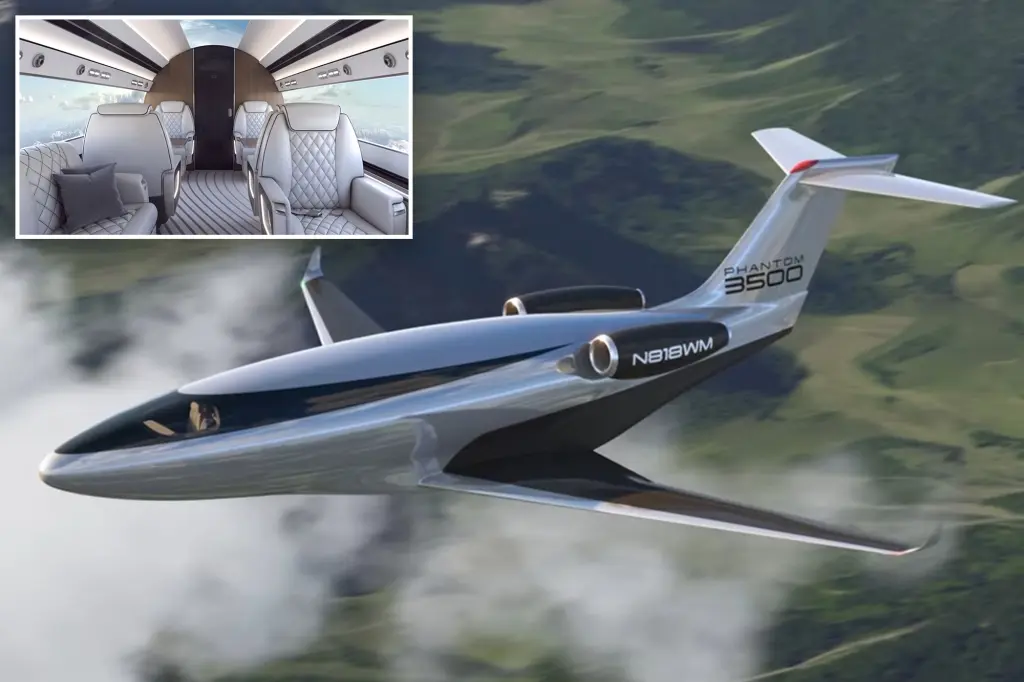The Future of Private Jets: Window-less Travel with a Digital View
The concept of a window seat on an airplane may soon become a relic of the past, at least for the ultra-wealthy. Otto Aerospace, an innovative aviation startup, has unveiled the Phantom 3500—a revolutionary private jet design that does away with traditional windows altogether. Instead, this futuristic aircraft features a teardrop-shaped cabin lined with six-foot digital panes that provide passengers with a virtual panoramic view of the outside world. As Otto Aerospace’s Chief Executive Paul Touw describes it, “You no longer have to lean over and look out the window. You could sit in our seat and look at the entire world around you… It is surreal.” This sci-fi-like experience is created through high-resolution cameras mounted on the exterior of the aircraft, offering passengers an enhanced feeling of being suspended in the sky—a technological marvel that particularly appeals to younger, tech-savvy travelers.
Despite its unconventional design, the Phantom 3500 has already generated significant market interest. Flexjet, a prominent private jet firm, has signed a contract to purchase 300 of these innovative aircraft over a six to eight-year period, with the first deliveries expected in 2030. Based on market pricing, this deal could potentially be worth approximately $5.85 billion, with each jet carrying a list price of around $19.5 million. While the exact negotiated value remains undisclosed, the magnitude of this commitment reflects a strong belief in the Phantom’s market potential. The nine-seater luxury aircraft, measuring 22 feet long and 7.5 feet wide, represents a bold departure from traditional private jet design that seems to have resonated with at least one major player in the private aviation industry.
Naturally, the idea of flying without conventional windows has sparked considerable debate and criticism. Some skeptics have likened the experience to “traveling in a giant coffin” or “flying in a big tin can,” expressing a preference for traditional views and fresh air over innovative design. Social media has been abuzz with comments questioning the appeal of a windowless fuselage, with many describing the concept as “awful” or dismissing it as another example of luxury marketing. These reactions highlight the emotional attachment many people have to the traditional flying experience, where physical windows provide both a visual connection to the outside world and a psychological comfort that digital screens, no matter how advanced, might struggle to replicate for some passengers.
However, the Phantom 3500’s unconventional design serves a purpose beyond mere aesthetics or technological novelty. According to Touw, the streamlined structure significantly enhances fuel efficiency, potentially reducing fuel consumption by 60% compared to current business jets—or even by 90% when using sustainable engine diesel. This remarkable improvement in efficiency could represent a major milestone for an industry that has been widely criticized for its substantial greenhouse gas emissions and is now striving to achieve net-zero goals by 2050. The environmental benefits of such a design innovation could potentially transform how we view private aviation, traditionally seen as one of the most carbon-intensive forms of travel available to individuals.
The economic implications of this fuel efficiency are equally significant. The potential cost savings could eventually make private flights more accessible, possibly even cheaper than flying business class in certain contexts. This development comes at a time when an increasing number of wealthy Americans are turning to private aviation for their travel needs. As Touw pointedly observes, “Everybody’s running around all excited about Firefly and SpaceX and Rocket Lab. The market for moving wealthy people around the world every day is actually much bigger than the market for moving stuff into space.” This perspective highlights the substantial economic potential of innovations in private aviation, an industry that continues to grow despite broader concerns about climate impact and economic inequality.
While Otto Aerospace has already built a full-size mock-up of the Phantom 3500 for conference demonstrations, the actual maiden flight of this revolutionary aircraft isn’t scheduled until 2027, as it still requires FAA certification. This timeline illustrates the lengthy development and regulatory process involved in bringing such innovative aircraft designs to market. The next few years will reveal whether this windowless wonder truly represents the future of private aviation or remains an interesting but ultimately niche concept. Regardless, the Phantom 3500 exemplifies how technological innovation continues to reshape our expectations of travel, pushing the boundaries of what we consider possible or desirable in air transportation. As with many technological advances, the initial reactions of surprise or skepticism may eventually give way to acceptance as the practical benefits—particularly the environmental advantages—become more apparent to a world increasingly concerned with sustainable transportation solutions.


